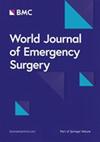Comparing percutaneous treatment and cholecystectomy outcomes in acute cholecystitis patients: a systematic review and meta-analysis
IF 5.8
1区 医学
Q1 EMERGENCY MEDICINE
引用次数: 0
Abstract
Acute cholecystitis (AC) is a common and serious condition characterized by gallbladder inflammation, most often caused by cystic duct obstruction due to gallstones. Although laparoscopic cholecystectomy (CC) is the preferred surgical treatment, percutaneous cholecystostomy (PC) is frequently considered for high-risk surgical patients. The optimal management strategy for these patients remains a topic of debate. These systematic review and meta-analysis aim to provide an updated evaluation of studies comparing the clinical outcomes of AC patients treated with PC versus those undergoing CC, as well as the outcomes of CC alone versus PC followed by CC. A literature search was carried out across Web of Science, Medline, Embase, and PubMed up to April 2024. Observational studies comparing patients undergoing PC versus CC, as well as CC versus PC followed by CC, and reporting mortality, morbidity, and readmission were included. Data extraction and quality assessment were independently performed by two reviewers, with bias risk evaluated using the Newcastle-Ottawa Quality Scale. The pooled odds ratio (OR) was obtained through meta-analyses by using STATA software (Version 18). A total of 27 studies were included, with 16 comparing PC versus CC and 11 assessing PC followed by CC versus CC alone. Meta-analyses revealed that CC was associated with significantly lower mortality (OR = 0.26; 95% CI = 0.14–0.48) and readmission rates (OR = 0.37; 95% CI = 0.18–0.75) compared to PC. The benefits of laparoscopic cholecystectomy over percutaneous cholecystostomy were particularly evident for mortality (OR = 0.17; 95% CI = 0.09–0.33), while a non-significant trend towards reduced readmission rates was also observed (OR = 0.28; 95% CI = 0.07–1.13). However, PC was identified as a viable alternative in high-risk surgical patients. Studies examining PC followed by CC versus CC alone showed diverse results, with some indicating reduced surgical complications and improved outcomes, while others reported no significant benefits. This work highlights that CC is associated with better outcomes, including lower mortality and readmission rates, compared to both PC alone and PC followed by CC. The combined approach did not show a significant advantage over immediate CC. Further research with larger studies and standardized protocols is needed to refine treatment strategies for high-risk AC patients.比较急性胆囊炎患者经皮治疗和胆囊切除术的结果:一项系统回顾和荟萃分析
急性胆囊炎(Acute cholecystitis, AC)是一种常见而严重的疾病,以胆囊炎症为特征,最常由胆结石引起的胆囊管阻塞引起。虽然腹腔镜胆囊切除术(CC)是首选的手术治疗方法,但经皮胆囊造口术(PC)经常被考虑用于高危手术患者。这些患者的最佳管理策略仍然是一个有争议的话题。这些系统综述和荟萃分析旨在提供最新的研究评估,比较AC患者接受PC治疗与接受CC治疗的临床结果,以及单纯CC治疗与PC后CC治疗的结果。截至2024年4月,在Web of Science、Medline、Embase和PubMed上进行了文献检索。观察性研究比较了接受PC和CC的患者,以及CC和PC之后的CC,并报告了死亡率、发病率和再入院率。数据提取和质量评估由两名审稿人独立完成,偏倚风险采用纽卡斯尔-渥太华质量量表进行评估。采用STATA软件(Version 18)进行meta分析,得出合并优势比(OR)。共纳入27项研究,其中16项比较PC与CC, 11项评估PC后CC与单独CC。荟萃分析显示,CC与显著降低的死亡率相关(OR = 0.26;95% CI = 0.14-0.48)和再入院率(OR = 0.37;95% CI = 0.18-0.75)。腹腔镜胆囊切除术比经皮胆囊造口术在死亡率上的优势尤为明显(OR = 0.17;95% CI = 0.09-0.33),同时也观察到再入院率降低的非显著趋势(OR = 0.28;95% ci = 0.07-1.13)。然而,在高危手术患者中,PC被认为是可行的选择。研究显示,与单纯行癌相比,行癌后行癌的研究结果不同,一些研究表明手术并发症减少,预后改善,而另一些研究则没有明显的好处。这项工作强调,与单独的PC和PC后CC相比,CC有更好的结果,包括更低的死亡率和再入院率,联合方法没有显示出比立即CC有显著优势,需要进一步的大规模研究和标准化方案来完善高危AC患者的治疗策略。
本文章由计算机程序翻译,如有差异,请以英文原文为准。
求助全文
约1分钟内获得全文
求助全文
来源期刊

World Journal of Emergency Surgery
EMERGENCY MEDICINE-SURGERY
CiteScore
14.50
自引率
5.00%
发文量
60
审稿时长
10 weeks
期刊介绍:
The World Journal of Emergency Surgery is an open access, peer-reviewed journal covering all facets of clinical and basic research in traumatic and non-traumatic emergency surgery and related fields. Topics include emergency surgery, acute care surgery, trauma surgery, intensive care, trauma management, and resuscitation, among others.
 求助内容:
求助内容: 应助结果提醒方式:
应助结果提醒方式:


